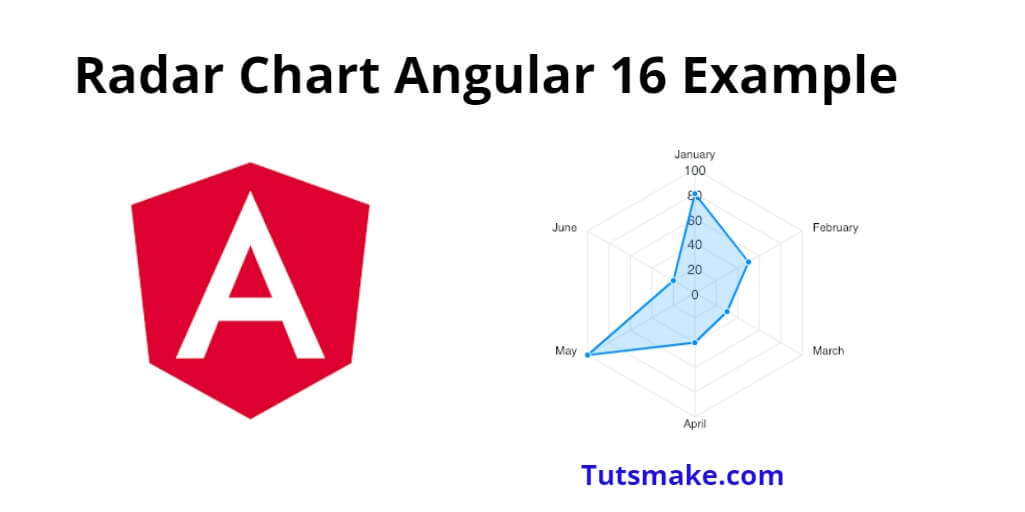A radar chart, also known as a spider chart or web chart, is a graphical representation that displays data on a two-dimensional plane with multiple axes originating from a common center point. This type of chart is often used to visualize and compare the performance or characteristics of different categories across various quantitative variables. Each axis represents a specific data attribute, and the data points are plotted along these axes to form a shape resembling a spider’s web or a star.
Radar chart in angular 16; In this tutorial, you will learn how to integrate Chart.js to create the radar chart in angular 16 projects or apps.
Angular 16 Radar Chart Example Tutorial
Steps to create a radar chart in angular 16 project using charts. js library:
- Step 1 – Set up the Angular project
- Step 2 – Install Chart.js
- Step 3 – Import Required Modules
- Step 4 – Add the Chart in the Component Template
- Step 5 – Import Components in Component ts File
- Step 6 – Start the Angular RADAR Chart App
Step 1 – Set up the Angular project
First of all, open your cmd or command prompt and execute the following command into it to install and create new angular project using cli:
ng new my-new-app
Step 2 – Install Chart.js
Next, execute the following npm command on cmd to install NPM ng2-charts chart.js and install bootstrap in your angular project:
npm install --save bootstrap npm install ng2-charts chart.js --save
Once you have installed charts.js in your angular project. Now you need to open angular.json file and update the following code into it:
"styles": [
"node_modules/bootstrap/dist/css/bootstrap.min.css",
"src/styles.css"
]
Step 3 – Import Required Modules
Next, you need to import some required module. So, visit src/app directory and open app.module.ts file. And then add the following lines of into app.module.ts file:
import { NgModule } from '@angular/core';
import { BrowserModule } from '@angular/platform-browser';
import { FormsModule } from '@angular/forms';
import { AppComponent } from './app.component';
import { ChartsModule } from 'ng2-charts';
@NgModule({
imports: [ BrowserModule, FormsModule, ChartsModule ],
declarations: [ AppComponent ],
bootstrap: [ AppComponent ]
})
export class AppModule { }
Step 4 – Add the Chart in the Component Template
Now, you need to add radar chart to angular project. So, visit src/app/ and app.component.html and update the following code into it:
<h1>Angular radar chart example - Tutsmake.com</h1>
<div style="display: block;">
<canvas baseChart
[datasets]="radarChartData"
[options]="radarChartOptions"
[labels]="radarChartLabels"
[chartType]="radarChartType">
</canvas>
</div>
Step 5 – Import Components in Component ts File
Next, import the component in the component.ts file. So, you need to visit the src/app directory and open app.component.ts. Then add the following code into the component.ts file:
import { Component, OnInit } from '@angular/core';
import { ChartDataSets, ChartType, RadialChartOptions } from 'chart.js';
import { Label } from 'ng2-charts';
@Component({
selector: 'my-app',
templateUrl: './app.component.html',
styleUrls: [ './app.component.css' ]
})
export class AppComponent {
public radarChartOptions: RadialChartOptions = {
responsive: true,
};
public radarChartLabels: Label[] = ['PHP', '.Net', 'Java', 'Android', 'Node.JS'];
public radarChartData: ChartDataSets[] = [
{ data: [62, 59, 80, 81, 56], label: 'Uses' },
{ data: [30, 48, 50, 29, 80], label: 'Popular' }
];
public radarChartType: ChartType = 'radar';
constructor() { }
ngOnInit() {
}
}
Step 6 – Start the Angular Radar Chart App
Finally, execute the following command on cmd to start angular radar chart app:
ng serve
Visit http://localhost:4200 in your web browser, and you should see the radar chart with sample data.
Conclusion
Congratulations! You’ve successfully created a radar chart using Angular and Chart.js. You can customize the chart further by exploring the options provided by Chart.js in the official documentation (https://www.chartjs.org/docs/latest/charts/radar.html).
